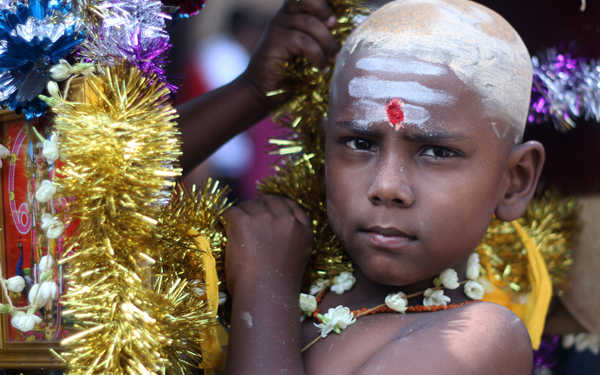“The child is taken to school, and the first thing he learns is that his father is a fool, the second thing that his grandfather is a lunatic, the third thing that all his teachers are hypocrites, the fourth that all the sacred books are lies!”.
~ Swami Vivekananda on Missionary Education.
During the colonial period, along with the invaders came the Missionaries. In 1700 CE, India had a share of 27% in world economy. The rich and developed country, for which Columbus and Vasco-da Gama once undertook the greatest risk in their lives, was one of the most backward countries of the world in the eyes of British and the Missionaries were the only harbingers of salvation who could save the Indians. In order to save the endangered Indians, these Christian Missionaries tried to eradicate anything and everything Hindu. Since India was a colonial empire with vast landmass and large population under the heels of the Queen, it was a cake-walk for them. The British regime itself supported them in their “sacred” missions.
- The Missionaries first targeted Hinduism and called it a false religion with false Gods. For example, people like Rev. Claudius Buchanan called Lord Jagannath Juggernaut, an evil deity and Hinduism a “bloody, violent, superstitious and backward religious system”. He called the “Juggernaut tradition” an endless meaningless bloodshed in which children were sacrificed in the “valley of idolatrous blood shed to false gods“. His book “Christian Researches in Asia” is the living testimony of how the Christian Missionaries operated in British Raj.
- The second attack was on the Indian academy and knowledge. The Missionaries, through their libelous reports, reviews and stories, succeeded in creating a very distorted image about the people and culture of India.
- The education by the Christian Missionaries destroyed the self-respect and self-confidence of the natives. The main aim was to fill contempt for their native culture in their heart so that mass conversions can be carried out.
- Those who were beyond the scope of Missionary Education were targeted in the name of social reforms. For an example, in 1892 the Christian Missionaries started a movement called “anti-dance movement” to abolishe any type of classical dance forms including Bharatnatyam, Kuchipudi, Odishi, etc. These dance were accused of being supportive of prostitution and under the influence of these Missionaries, the Madras Presidency even banned the custom of dancing in any Hindu temples in 1910. After humiliating the dancers, they even suppressed them economically by pressuring their patrons to cease financial support.
However, India gained its independence. The yoke of British regime was overthrown, and the agents from Vatican did not have the authority to abolish Hindu traditions and cultural values forcefully. They were left with only one way to infuse the contempt for Hinduism in the minds of Hindus- that was through their education system.
Recently, some Hindu students of a Christian Minority Matriculation School in Keezhapudur, were punished for bursting firecrackers in Deepawali. According to the complaint lodged by S. Sethuraman in Palakkarai police station, his son and some other Hindu students were punished for bursting crackers. Students who had burst crackers were forced to bow their head as a part of seeking pardon from nature (for causing pollution) during a prayer session. Seven students, who did not burst crackers, were given appreciation letter. Apart from this, the Physical Education teacher of the school had beaten a girl on her palms with a scale because she was wearing Mehendi on her palms. This incidence raises some questions:-
1.The children did not burn crackers within the school premises and so, there was no breach of conduct in school. Why were the children punished for bursting crackers at their homes? Does the Christian school have the right to regulate what a student does in his home?
2. The children were asked to beg pardon from nature. Does the school administration ask its Christian students to beg pardon from nature when they burn crackers during the Christmas or New Year?
3.What does the Christian School think about cutting down trees to set up Christmas trees during Christmas? Does it also harm the nature, the way the crackers do during Deepawali?
When police tried to investigate the matter, the head mistress told that they acted as per the instruction forwarded by the Chief Education Officer. On the other hand, the Chief Education Officer is said to have forwarded the instructions, which was given by the Tamil Nadu Pollution Control Board to the school. This claim is yet to be probed since the TNPCB guidelines reported by Deccan Chronicle, do not contain any instruction that deals with any school.
Punishing some students for bursting crackers and giving appreciation letter to those who did not burst crackers will lead to a behavioral change. Punished students will think that bursting crackers “during Deepawali” is a sin and from next year, they will refrain from celebrating Deepawali. That is an intellectual way of brainwashing small kids and filling contempt for Hinduism in their heart.
Apart from the Keezhapudur episode There have been numerous such incidents where Christian and Convent schools have systematically carried out their agenda. We list out 5 more such cases:
1. In February 2015, an 11-year old girl of St. Ann School in Secunderabad, Telangana was forced to stand outside Principal Sally Joseph’s room for two hours as punishment for wearing a Tilak on her forehead. The Principal even tried to issue a transfer certificate. India is a secular country where terrorists are called misguided youth and government tries to rehabilitate them by providing jobs, while on the other hand, a Principal tries to harm the academic career of a student for wearing a Tilak.
- In September 2015, some girl students of St Mary’s Convent School were forced to stand in sun as punishment for wearing Rakhi and Mehendi. One girl was forced to rub her hands on a rock to remove the Mehendi and thus, her hand was injured. Upon asked, the administration came up with an excuse that no religious symbols are allowed inside the school. However, the Christian teachers of the school can wear Christian crosses around their neck.
Check the cross on Christian teachers of the school which says all religious symbols are banned in the school pic.twitter.com/oUqETfwRuZ
— We, the people of India (@India_Policy) September 2, 2015
- In October 2015, a Christian school named Doveton Girl’ & Boys’ Hr. Sec. School in Vepery, Chennai, imposed a fine of Rs. 500 on a class II Student for having faded Mehendi traces on his palms. The mehendi was applied on his palms during a family ceremony on September 23, when the school was closed after quarterly exams. When the school reopened on October 5, the school authorities fined the child. In another case, a girl from the same school was fined Rs. 500 for having Mehendi traces on her hand.
will surely get this investigated!
— Pandiarajan K (@mafoikprajan) October 15, 2016
- In June 2016, another regressive anti-Hindu incident took place when St Vincent Pallotti School of Bengaluru had expelled an LKG student for having a Sikhaor Tiki (ponytail). The student’s father Manjunath requested that it is a family custom to keep Shikha till the kid is 5-years old, but Principal Paul D’Souza expelled the student in midterm by saying that their school does not allow superstitious beliefs. The authorities mishandled a student’s education for following a family tradition.
- In January 2017, the authorities of St. Joseph school had suspended two boys for having sandalwood paste (Vibhooti) on their forhead.
St. Joseph school Rameswaram suspended two boys for having vibuthi in forehead. #MissionaryMafia crossing all limits #Church #atrocities pic.twitter.com/8oI2rxzHOB
— ௐ ஹிந்து (மோடியின் குடும்பம்) (@isitso15) January 5, 2017
The above incidents tell an unsettling story of the systematic way of humiliating Hindu students in Christian Schools and making them feel disgraced by targeting their religious customs and traditions.
These punishments aim at developing an inferiority complex or contempt in the minds of the students regarding their culture. The more this inferiority complex develops, the more these children will be distanced from their cultural identity.


































